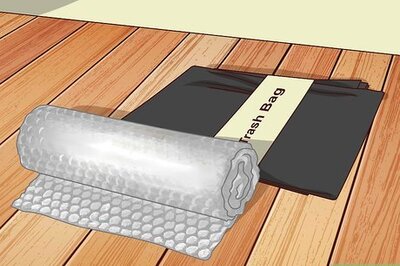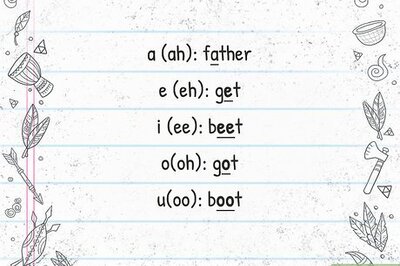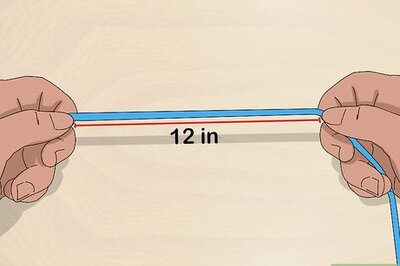
views
Reporting a Workplace Health-and-Safety Matter

Understand workplace safety laws. State and federal law is written to protect workers from occupational and health hazards. In some states a public agency is charged with investigating complaints and enforcing labor laws. Employees have the right to complain about hazards to such an agency. If a state does not have an agency of its own, workers can report hazards to the federal Occupational Safety and Health Administration, commonly known as “OSHA.”

Gather proof of unsafe work conditions. Examples of workplace hazards include uncovered floor openings, improperly stored hazardous material, and poorly maintained tools and equipment. Excessive heat at work and a lack of shade in outdoor workplaces also qualify as hazards. To determine whether or not you have a hazard, use this checklist. It can help you identify potential hazards that you should report.

Collect important information. In order to complete a complaint form, you should gather pertinent information ahead of time. In addition to details about the hazard, you will need the following information: how many employees work at the site and how many have been exposed to the hazard when and how these workers were exposed what type of work is performed in the hazardous area what type of equipment is used and its condition the materials or chemicals used whether employees have been trained or informed regarding the hazard the kind of work done nearby, including how often and for how long employees work near the hazard how long you have known the hazard exists attempts to address the hazard whether anyone has been injured or made ill as a result of the hazard any “near miss” incidents

Obtain a complaint form. You will file a complaint with the applicable agency. If you have a state agency, you will need to request a form from them. If you need to make a complaint with OSHA, you can file a complaint online by visiting this page. You also have the option of downloading an OSHA complaint form and faxing or mailing it to your regional OSHA office. A list of OSHA offices can be found here. In California you cannot file a complaint online, but you can download a form. File the form with the appropriate state office.

Complete the form and file. You will need to sign the form. However, you may elect to have the agency keep your identity anonymous. You should keep a copy of the form for your records.

Wait for a response. After you file a complaint, OSHA evaluates it to determine whether it is necessary to perform an off-site or an on-site investigation. OSHA gives top priority to investigating complaints of hazards that pose an “imminent” danger. An imminent danger is one that could reasonably be expected to cause death or serious physical harm immediately or before it can be eliminated through enforcement procedures. Investigations under state laws can vary. In California, Cal-OSHA is required to inspect a job within three working days after a complaint is filed by a worker or worker representative (i.e., union or attorney). Each complaint is classified to determine inspection priority, with “imminent danger” hazards afforded top priority. In the case of an anonymous complaint, rather than conducting an on-site inspection the state agency may send a letter to the employer asking them to investigate and correct unsafe working conditions. If the employer does not respond, or if investigation or corrections are insufficient, the state agency will conduct an on-site inspection.

Watch for retaliation. Your employer cannot retaliate against you for filing an OSHA complaint. Specifically, you cannot be fired, demoted, harassed, or transferred to a less desirable position or shift because you filed the health-and-safety complaint. If you suspect that your employer is retaliating against you, you may file a retaliation complaint with OSHA within 30 days of the alleged retaliation.
Reporting a Violation of Wage Laws

Research applicable minimum-wage laws. Both state and federal laws determine the minimum hourly rate employees must be paid. These laws are known as “minimum wage” laws. According to the Fair Labor Standards Act (FLSA), the hourly minimum wage for an employee is $7.25. Many states, however, have higher minimum wages that take precedence. For a complete listing of state minimum- wage laws, click here. Federal and state laws also regulate how overtime pay is calculated. If you live in a state where federal and state laws differ, the higher standard applies. Under the FLSA, eligible employees must be paid overtime for hours worked in excess of 40 in any given work week. The overtime pay, known as “premium pay,” must be at least 1.5 times your regular rate of pay. For example, if your regular rate of pay is $9.00 an hour, then your premium pay must be at least $13.50 an hour. In many states, you can earn premium pay if you work more than eight hours in a day. You can also earn double pay if you work more than 12 hours in a day. Furthermore, some states (like California) award premium pay if you work seven straight days. On the seventh day the employee receives premium pay for the first eight hours worked on this day and then receives double their rate of pay for hours in excess of eight on the seventh day.

Check if you are eligible. Both state and federal laws exempt certain employees from minimum-wage and overtime pay requirements. For example, employees at seasonal amusement or recreation establishments are exempt from both minimum-wage and overtime laws. People who work in executive, administrative, or professional positions are also exempt. To view a list of exempt employees, check here. Contrary to popular opinion, you are not exempt from overtime rules simply because you are paid a salary. Salaried employees are exempted from overtime laws only if they are paid a salary of at least $455 a week and perform the duties of an exempt employee.

Calculate your overtime pay. Once you understand your state’s laws, you can calculate your premium pay. For example, if you live in a state that follows the FLSA, you will receive 1.5 times your regular rate of pay for hours worked in excess of 40 in a work week. For example, if you work 44 hours in a work week, 40 of those hours are paid at your regular rate ($7.25 x 40 = $290.00). The additional four hours are paid at a rate of 1.5 times your regular rate of pay, so multiply those hours (four) by your regular rate ($7.25) and again by 1.5. In this example you earned an additional $43.50 in overtime. If your state mandates overtime pay for hours in excess of eight a day, you can calculate the overtime. For example, you may work four eight-hour days and two ten-hour days in a week. You will earn premium pay for those extra hours. Accordingly, calculate your regular rate of pay for the 32 regular hours you worked: $9.00 x 32 = $288.00. Then, calculate your premium pay for the additional four hours: $9.00 x 4 x 1.5 = $54.00.

Find your state labor-law office. If your employer does not pay you at least a minimum wage or the required overtime wages, you can file a complaint with your state’s labor office. To view a listing, click here. Your state office may have complaint forms online. To view Missouri’s, click here. If you live in a state that does not have its own labor agency, you may file a complaint with the U.S. Department of Labor’s Wage-and-Hour Division. You can file a complaint by visiting your local office or by calling the toll-free helpline at 1-866-487-9243.

Present all relevant information. You will need the following information to help you file a complaint with the Department of Labor: your name, address, and phone number the name of the company you work for the location of the company (this may be different from the location where you work) the company’s phone number the name of the manager or owner the type of work you do how and when you are paid (copies of pay stubs would be helpful)
Reporting an Unfair Labor Practice

Understand that your rights are protected. An unfair labor practice is a violation of an employee’s rights, such as the right to organize, form, or join a union. You are also protected from unfair practices committed by unions. Examples of unfair labor practices include: interfering with an employee’s right to organize, form, join, or assist a labor organization interference with an employee’s right to bargain collectively threatening employees with job or benefit loss for voting to join a union threatening to close shop if workers vote to join a union threatening bodily injury to non-striking employees fining or expelling union members for crossing an unlawful picket line refusing to process a grievance in retaliation against an employee who criticizes union officers when the union is the exclusive bargaining representative

Locate the appropriate NLRB office. If you work for a private employer, an unfair-labor-practices complaint can be filed with the National Labor Relations Board (NLRB). Examples of private employers include manufacturers, retailers, private universities and private health-care facilities. The NLRB does not cover federal, state, or local government workers. To find the NLRB regional office near you, search here. If you are a federal government employee, you are covered under the Federal Service Labor-Management Relations Statute and should contact the Office of the General Counsel. You can find your regional office by clicking here.

Get the appropriate form. The appropriate NLRB form will depend on whether you are filing a complaint against your employer or against your union. If filing a complaint against your employer, you will need Form NLRB-501, available here. If you are filing a complaint against your union, you will need Form NLRB-508, which is available here. If you are a federal employee, you will need either FLRA Form 22 “Charge Against an Agency” or FLRA Form 23 “Charge Against a Labor Organization.”

Address your state's labor-relations board. If you work for a public employer, you would file an unfair labor practices complaint with the agency responsible for administering state laws which govern public employment. For example, the California Public Employment Relations Board administers the laws that govern employees of California’s public schools, colleges, and universities (as well as various other employers).

Find the appropriate state form. You should contact the state agency and ask for the pertinent form. Forms differ from state to state. In California, for example, there is a form online for you to use whether you are bringing a charge against an employer or a union. To view this example, click here.

Complete the forms. The forms will ask for basic information about either your employer or union, including their name, address, and telephone number.Additionally, you will need to provide a factual summary of your complaint. You may also be asked if you have raised the issue as part of any other grievance procedure. Don't wait to report. Generally you must report an unfair labor practice within six months of its occurrence. If you have questions, you may call your regional or state office.

Wait. After you file a complaint with the NLRB an agent will investigate your charge by interviewing witnesses and various other parties. The agent’s findings will be reviewed by the NLRB regional director, and a decision will be made about whether to issue a complaint. If the NLRB determines that there is enough evidence, the agency may issue a complaint. This would result in a hearing before an NLRB administrative law judge. Complaints filed with your state will be handled according to state procedures. In California, for example, filed complaints are reviewed by a Board Agent. The entity you filed the complaint against will have an opportunity to respond to the allegations. After reviewing the opposing party’s response, the Board Agent will evaluate whether the charge meets the minimum standard for violating the law. If it does not, the agent will send a “warning letter” and allow you time to correct the complaint. If the agent determines that the complaint does meet the legal standard, it will issue a complaint and initiate proceedings for an informal settlement.

Negotiate. You have the option of negotiating with your employer or union and reaching an amicable settlement which satisfies all parties. If this happens, you may then withdraw your complaint. If you wish to negotiate, you may want to speak to an experienced labor lawyer first. To find such a lawyer, you should visit your state’s bar association in person or online, and inquire about their referral program.
Reporting a Violation of the Family Medical Leave Act

Read your determination letter. After you apply for family medical leave, your employer must respond within five days, telling you whether you are eligible. If you are denied, your employer must give a reason for the denial. Your determination letter will state that reason.

Expect to be returned to the same job. If you are granted leave, your employer must return you to the same or similar job once you return to work. Although the job does not have to be identical, it must be “nearly identical.” The new position must: involve the same or substantially similar responsibilities, duties, and status carry the same general level of skill, effort, responsibility, and authority offer identical pay, overtime, and bonus opportunities offer identical benefits (life, health, and disability insurance, sick leave, vacation, pensions, etc.) offer the same general work schedule at the same or a nearby location

Gather pertinent information. To facilitate the complaint process, you should gather necessary information ahead of time. You will need the following: your name, address, and phone number the name of the company where you work the location of the company the name of your manager or the company owner the circumstances of your FMLA request and your employer’s response

Contact the U.S. Department of Labor. To lodge a complaint, you should contact the Department of Labor’s Wage-and-Hour Division. Call 1-866-487-9243. You will be directed to the nearest office for assistance.




















Comments
0 comment